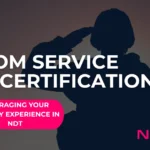20 Common NDT Interview Questions and How to Answer Them
An interview for a Non-Destructive Testing (NDT) position is a high-stakes conversation. It goes far beyond a typical job interview. The hiring manager isn’t just assessing your skills; they are evaluating your judgment, your integrity, and your commitment to safety—qualities that are essential when you are responsible for the integrity of critical infrastructure.
Preparation is the key to demonstrating your true value as a professional. To help you succeed, we’ve compiled a comprehensive list of 20 common NDT interview questions. This guide is broken down into four key categories and provides not only the question, but also the strategy behind why they are asking and how you should frame your answer.
Part 1: Foundational & Technical Questions
These questions are designed to verify your core knowledge and ensure you have a solid technical foundation.
1. Which NDT methods are you certified in, and to what level?
- Why they’re asking: This is the baseline question to confirm your qualifications match the job requirements.
- How to answer: Be clear and specific. State the method and your certification level (e.g., “I am currently a certified Level II in Ultrasonic and Magnetic Particle Testing, in accordance with our company’s SNT-TC-1A written practice.”).
2. Walk me through your process for calibrating your equipment for [a specific method, e.g., a shear wave UT inspection].
- Why they’re asking: They are testing your understanding of procedure and your attention to detail. Calibration is a fundamental, non-negotiable step for accurate inspection.
- How to answer: Describe the process systematically and methodically. Mention the specific calibration blocks you would use, the functions you would check (e.g., screen linearity, resolution), and the importance of documenting the calibration before and after the inspection.
3. What NDT-related codes and standards are you most familiar with?
- Why they’re asking: This assesses your industry-specific knowledge. NDT is governed by codes (like ASME, API, AWS), and your ability to work within these frameworks is crucial.
- How to answer: Be specific. Instead of just saying “ASME,” mention a specific section, like “I have extensive experience performing weld inspections in accordance with ASME Section V and using the acceptance criteria outlined in Section VIII.”
4. Describe the information you believe is most critical to include in a final inspection report.
- Why they’re asking: The report is the final product. This question tests your understanding of documentation and communication.
- How to answer: List the key components: identification of the part, the procedure used, equipment serial numbers, calibration details, a clear summary of the findings (including location and size of any indications), and your signature and certification level.
5. What is the difference between an “indication” and a “defect”?
- Why they’re asking: This tests your grasp of fundamental NDT vocabulary. It’s a simple but telling question.
- How to answer: Clearly state that an indication is any response or evidence from an NDT test that requires interpretation. A defect is a specific type of indication that is rejectable because it does not meet the acceptance criteria of the code or standard.
Part 2: Behavioral & Situational Questions
These questions probe how you have acted in past situations to predict your future performance. The best way to answer them is using the STAR method: Situation, Task, Action, Result.
6. Tell me about the most challenging inspection you’ve ever performed.
- Why they’re asking: They want to see your problem-solving skills and technical limits.
- How to answer (STAR): Describe the Situation (e.g., a complex geometry part), the Task (to perform a complete inspection), the Action you took (developed a specific scanning plan, consulted with a Level III), and the Result (successfully completed the inspection and identified a critical flaw).
7. Describe a time you found a critical or unexpected defect.
- Why they’re asking: This reveals your judgment under pressure.
- How to answer (STAR): Explain the Situation (routine inspection), the Task (following the procedure), the Action you took upon finding the flaw (immediately stopped, verified the finding, and reported it directly to your supervisor and the client per protocol), and the Result (the component was removed from service, preventing a potential failure).
8. Have you ever had a professional disagreement with a supervisor or client about a result? How did you handle it?
- Why they’re asking: This assesses your professionalism, communication skills, and integrity.
- How to answer (STAR): Describe the Situation (a disagreement on the interpretation of an indication). The Task was to ensure the correct call was made. The Action should be professional: “I respectfully explained my technical reasoning, referenced the specific section of the code, and we reviewed the data together. The goal was never to ‘win,’ but to arrive at the correct, compliant conclusion.” The Result should be positive (a correct disposition was made, and the professional relationship was maintained).
9. How do you maintain focus during long, repetitive inspection tasks?
- Why they’re asking: This probes your self-awareness and discipline. Complacency is a major risk in NDT.
- How to answer: Mention specific strategies: taking short, scheduled breaks to rest your eyes, systematically breaking the large job into smaller, manageable sections, and consciously double-checking your work at set intervals.
10. Describe a time you had to work under a tight deadline without compromising quality or safety.
- Why they’re asking: This tests your time management and ability to perform under pressure, a common scenario in turnarounds.
- How to answer (STAR): Detail a Situation (a critical path job in a shutdown). The Task was to complete it quickly. The Action was to carefully plan the workflow, ensure all equipment was ready beforehand, and communicate clearly with the team, while strictly adhering to every step in the safety and inspection procedures. The Result was that the job was completed on time, allowing other crafts to proceed without delay.
Part 3: Safety & Ethics Questions
These are the most important questions in the interview. Your answers here are often pass/fail.
11. How do you ensure you are always in compliance with safety regulations?
- Why they’re asking: They need to know that safety is your top priority. According to OSHA, a strong safety culture is a key indicator of a well-run company.
- How to answer: Your answer should be proactive. “I start by participating in the pre-job safety brief, reviewing the JSA, and ensuring I have all my PPE. Throughout the day, I maintain situational awareness and am never hesitant to use my Stop Work Authority if I see any unsafe condition.”
12. Imagine you are pressured by a client to sign off on an inspection you are not confident is 100% accurate. What would you do?
- Why they’re asking: This is the ultimate test of your integrity.
- How to answer: There is only one right answer. “I would respectfully and professionally refuse. I would explain that my signature certifies that the inspection was performed correctly and that I cannot sign off until I am completely confident in the results. I would then immediately elevate the situation to my supervisor or Level III.” This aligns with the ASNT Code of Ethics, which mandates that technicians act with integrity.
13. Can you provide an example of a time you identified a potential safety hazard?
- Why they’re asking: They want to see if you have a proactive safety mindset.
- How to answer (STAR): Describe a Situation (e.g., noticing a frayed electrical cord on a piece of equipment), the Task (to ensure a safe worksite), the Action (I immediately took the equipment out of service and reported it to my supervisor for repair), and the Result (a potential electrical hazard was prevented).
14. What does “Stop Work Authority” mean to you?
- Why they’re asking: This tests your understanding of modern safety culture.
- How to answer: “Stop Work Authority means that every single person on a job site, regardless of rank or experience, has both the right and the responsibility to stop any job they believe is unsafe, without fear of retaliation. It’s a critical tool for preventing accidents.”
Part 4: Career & Motivation Questions
These questions help the interviewer understand your passion, ambition, and if you are a good long-term fit for their company.
15. How do you stay updated with the latest NDT technologies and standards?
- Why they’re asking: This reveals your passion for the field and your commitment to professional development.
- How to answer: Mention specific resources: reading industry publications like ASNT’s Materials Evaluation, attending local ASNT chapter meetings, following industry leaders online, or taking refresher courses.
16. What are your long-term career goals in the NDT field?
- Why they’re asking: They want to know if you have ambition and if your goals align with the opportunities they can provide.
- How to answer: Be honest and specific. “My immediate goal is to become a top-tier Level II technician. Long-term, I am interested in pursuing a Level III certification and potentially moving into a technical leadership or quality management role.”
17. Why are you interested in working for our company specifically?
- Why they’re asking: This shows if you’ve done your research.
- How to answer: Mention something specific you learned about them. “I’m drawn to your company’s strong reputation in the aerospace sector,” or “I was impressed by your company’s investment in advanced technologies like Phased Array UT.”
18. What do you believe is the most important quality for a successful NDT technician?
- Why they’re asking: This gives insight into your personal values.
- How to answer: While technical skill is important, the best answers revolve around character: integrity, attention to detail, or a commitment to safety.
19. How do you handle constructive criticism from a supervisor or mentor?
- Why they’re asking: They need to know if you are coachable.
- How to answer: “I see it as a valuable learning opportunity. I listen carefully, ask questions to make sure I understand, and focus on using that feedback to improve my performance.”
20. Do you have any questions for me?
- Why they’re asking: This shows your level of engagement and interest.
- How to answer: Always say yes. Prepare at least two thoughtful questions. Great questions to ask include: “What does success look like for someone in this role after six months?” or “What opportunities for advanced training and professional development does your company offer?”
An NDT interview is your chance to prove you are more than just a certificate-holder. You are a professional who can be trusted with critical responsibility. By preparing thoughtful, honest, and strategic answers to these questions, you can confidently demonstrate that you are the right candidate for the job.
Ready to put your preparation to the test? Find your next opportunity and connect with top employers hiring now on NDT-Jobs.com.



